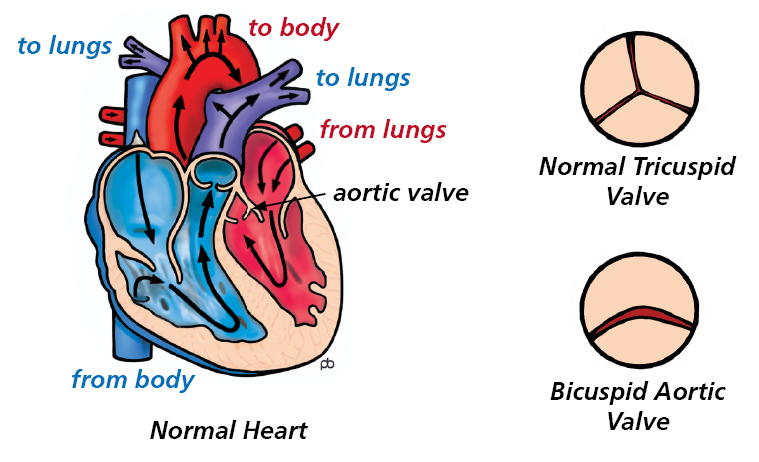
The main pumping chamber of the heart, the left ventricle, pumps blood to the body through a large artery called the aorta. Between the left ventricle and the aorta is a one way valve, the aortic valve, that prevents blood coming back into the heart once it has been pumped out.
The aortic valve is usually made of three leaflets that open and close as the blood is pumped out.
About 1-2% of people have aortic valves that have two leaflets rather than the usual three. This is known as a Bicuspid Aortic Valve (BAV). This is usually an incidental finding and these valves can function very well throughout life but do have a tendency for the valve to become narrow and/or leak as people get older. As well as an abnormality with the valve, people with bicuspid aortic valves frequently have an abnormality with the main blood vessel (aorta) leaving the heart too, causing it to become stretched.
Tests
Usually only simple tests such as an ultrasound scan of the heart (“echocardiogram”) are needed to make a diagnosis. This valve will then require monitoring every few years in the Outpatients department, to ensure it continues to function well and does not start to leak or become narrow. Sometimes the main blood vessel, the aorta may stretch (dilate) over years with the risk of a tear once it gets beyond a certain size. This is why it is important that your cardiologist monitors this by scanning your valve and the aorta.
General advice
Patients with a Bicuspid Aortic Valve are at risk of infection in the heart (called endocarditis), especially if the valve has a mild leak. Endocarditis may be caused by infections of the teeth or gums. It is important to visit the dentist regularly (every 6-12 months) and to follow good dental hygiene. Any procedures that break the skin such as tattooing, body piercing and cosmetic treatments, including eyebrow microblading, Botox and dermal fillers are best avoided as they also carry a small risk of infection which may spread to the heart.
Children with bicuspid valves who do not have narrowing or leak should not be restricted in terms of activity or exercise and should be treated as normal unless there are other associated problems with the heart.
A bicuspid aortic valve can be passed down in families (inherited). We recommend that you, as parents, are screened. If you are found to have a BAV then your first degree relatives have a risk of approximately 25% of having one too. Ask your GP to refer you to a local cardiologist for a heart scan (for yourself) or a paediatrician who specialises in cardiology at your local hospital for other children if you are affected.